Itek Tim is a simply flavoured, sour duck soup that is perfect with a bowl of steamed white rice.
Estimated reading time: 11 minutes

What’s in a Name?
Let’s take a look at the name first, shall we? It’s actually a combination of 2 local languages, a common practice within the local communities in Singapore and Malaysia.
- Itek = duck, in Malay
- Tim = refers to the slow simmer of the duck in Hokkien, a Chinese dialect
Itek Tim Soup
So Itek Tim is a soup where the duck has been simmered in a base of pickled vegetables, dried tamarind slices and preserved plums, resulting in a light and fairly sour soup. Some families will insist on minimal flavourings and additions, keeping it a clear soup that almost resembles a consommé. While others prefer a soup with a deeper flavour, resulting in a “cloudy” look. I’m definitely in the second camp.
Itek Tim is a dish that’s synonymous with festivities in the Peranakan community. For many Nyonya families, it always makes an appearance on the Chinese New Year Tok Panjang. It is also a very popular dish at other celebrations and also religious festivals like the Hungry Ghost Festival.
By the by, wondering about Nyonya (and Peranakan, below)? Head on over to the Recipes page here to read up more.
Tok Panjang
- Tok = table, a derivation of the same word in Hokkien
- Panjang = long, in Malay
So, literally, long table.
But what it really refers to is a feast, and an extravagant one at that. Tok Panjang will include sides, mains, condiments, soups, desserts and so on. Like a buffet table that offers everything, and very, very similar in concept (not execution) to the Kashmiri Wazwaan. If you’re interested, you can read about Kashmiri food culture and get some recipes here on LinsFood.
Some Background?
Itek Tim is most certainly of Chinese origin. There are a few soups featuring similar ingredients, especially in South Eastern China, in provinces like Guangdong and Fujian. Some insist that it is of Teochew origin (Guangdong), while others insist it’s Hokkien. As with any good recipe, it travels, it evolves and it is naturally claimed by many.
Just to throw a spanner in the works, the Eurasians in Malacca have also for a few hundred years, been making a similarly sour soup called Teem Reunion Soup. This soup predates the British occupation and is a legacy from the Portuguese, taking on local additions as the years went by.
You can read more about Malacca’s colourful history here on LinsFood.
During and after the Portuguese occupation (1511 – 1641), teem reunion soup was served at Christmas by the Seranis (Eurasians) with reunion biscuits. If I had to guess, these reunion biscuits are akin to the scones of today and were also traditionally served with Curry Devil, that iconic Eurasian Christmas curry.
I’ve seen the odd article that states the word teem means snow peas or spiced snow peas soup. But I can’t find any confirmation of this, not written, nor amongst any of my older Eurasian community members.
Suffice it to say though, however this Eurasian reunion soup started, it obviously evolved over time, taking on many local influences, like the duck, the pickled mustard leaves and tamarind slices, amongst other things. Its name got shortened to Itek Teem, which eventually became Itek Tim.
Incidentally, the Portuguese word temperado means tempered or flavoured. I wonder whether this is where the the word teem comes from. Like in Telur Tempra.
But let’s get on with the recipe!
Itek Tim Recipe
It’s a very easy recipe to cook, although it does require a few ingredients that you’ll need a Chinese grocer for. Or get them online. We’ll take a look at the ingredients in a bit.
As far as cooking itek tim is concerned, this is what we’ll be doing:
- Prep work – chopping, slicing ingredients and soaking of the mustard leaves (only 10 minutes).
- Place most of the ingredients in your saucepan and simmer for 30 – 45 minutes.
- Add the mustard leaves and simmer for another 10 minutes.
- Add tomatoes, check seasoning and you’re done.
Easy, right?

Ingredients
Let’s take a look at the ingredients used for cooking itek tim.
Duck
Traditionally, a whole duck, chopped up into portions would have been used to make this Peranakan soup. But I much prefer to use a combination of duck legs and breast, so I get more meat for the weight. I’m the same with chicken too, although with chicken, I usually skip breast meat as I find it awfully bland.
So for the amount in today’s recipe, I’ve given a weight of 1 kg (2.2 lb) of duck portions. You can use whatever portions you like, or go for a whole duck.
We’re going to be chopping up our duck, so if you get your meat from a butcher, get him to do it, to save time. Chop each duck leg into 3 portions.
If you are not keen on the duck skin, you can remove it. However, I prefer to keep it on as I think duck and chicken skin add to whatever dish they are used in. And I love them!
The same goes with the fat. Duck is a fatty meat, so feel free to cut out all the excess.
Pickled Mustard Leaves (Kiam Chye)
Pickled mustard leaves are very, very important in cooking itek tim, and you can’t make it without. They are salty and also a little sour from the pickling brine and are responsible for the predominant flavour in our Nyonya soup today.
You should be able to find these salted mustard leaves at any Chinese grocer, and most certainly online. I’m lucky to have one just a 5-10 minute walk away.
Kiam Chye is actually very easy to make at home if you really, really don’t have access to them. I’ve made them on occasion over the years when I’ve grown mustard leaves. Perhaps a recipe sometime in the future?

Asam Gelugur
Want to keep cooking Singaporean and Malaysian? You want to know the difference between asam gelugor and asam jawa (tamarind). Click here to read more about tamarind.
Asam gelugur is the sliced rind of the Garcinia atroviridus fruit, native to Malaysia, image below. Also known as asam keping, it is extremely sour, and is used as a souring agent, just as commonly as tamarind (asam jawa). Looking at the image below, they kind of resemble miniature squash, don’t they?

Asam gelugur slices are usually air dried before being sold, giving you hard, dried slices. But you can also find them semi fresh, which have been salted and packed. That’s what you can see in the image below.
However asam keping is prepared, all you do to use it is drop into whatever soup, stew or curry you are cooking. That’s it. I love its sour nature and always eat it along with the dish.
I’ll do a whole post on asam gelugur soon! Ps: the old Malay spelling was gelugor, in case you see both online. I still sometimes spell it with an ‘o’ out of habit.
Can’t get asam gelugur? Use 1 Tbsp tamarind pulp (or paste) or 1 tsp of clear vinegar instead. We don’t want to use too much of either, as unlike asam gelugur, they both have just a hint of sweet too.

Preserved Sour Plums
Yet another souring agent in our itek tim, adding even more salty and sour to our soup. These plums are preserved in brine, so are soft and wet, unlike the dried ones that are eaten as a snack all across East and South East Asia. They will also be found in Chinese grocers or online.
Can’t get preserved sour plums? If you can find the Japanese umeboshi, you could use that, but just 1 for the recipe here. Umeboshi are also salted, preserved plums, and are easier to find in the UK. Otherwise, just leave them out.

Aromatics, Vegetables & Spices
The ingredients we looked at above are the major players. Everything else only plays a small part, but still helps to complete the final flavour. This is where the variation comes in, from family to family. Some don’t use any aromatics at all, preferring to let the preserved and souring ingredients do the talking.
Let’s take a look at what I use.
- garlic
- ginger
- tomatoes
- birds eye chillies
- peppercorns
- star anise
That’s it, and we only use a little of everything.
Stock or Water?
This is a matter of preference. Some families will add pork or chicken bones to this Nyonya duck soup to enhance the final flavour. While others, especially in the modern world, will add some chicken stock.
If you love making homemade stock, this is a great recipe to use it for. And if you recall, we made homemade Chinese chicken stock some weeks ago, here on SMR. Click here for the recipe.
The problem with shop bought stock in the West is that it has been flavoured with lots of aromatics and vegetables. Chinese stock, on the other hand, is an altogether lighter affair. And so, so easy to make at home!
But go ahead and use shop bought stock cube or pot, but use only 1 portion, if you prefer. Not judging.😉
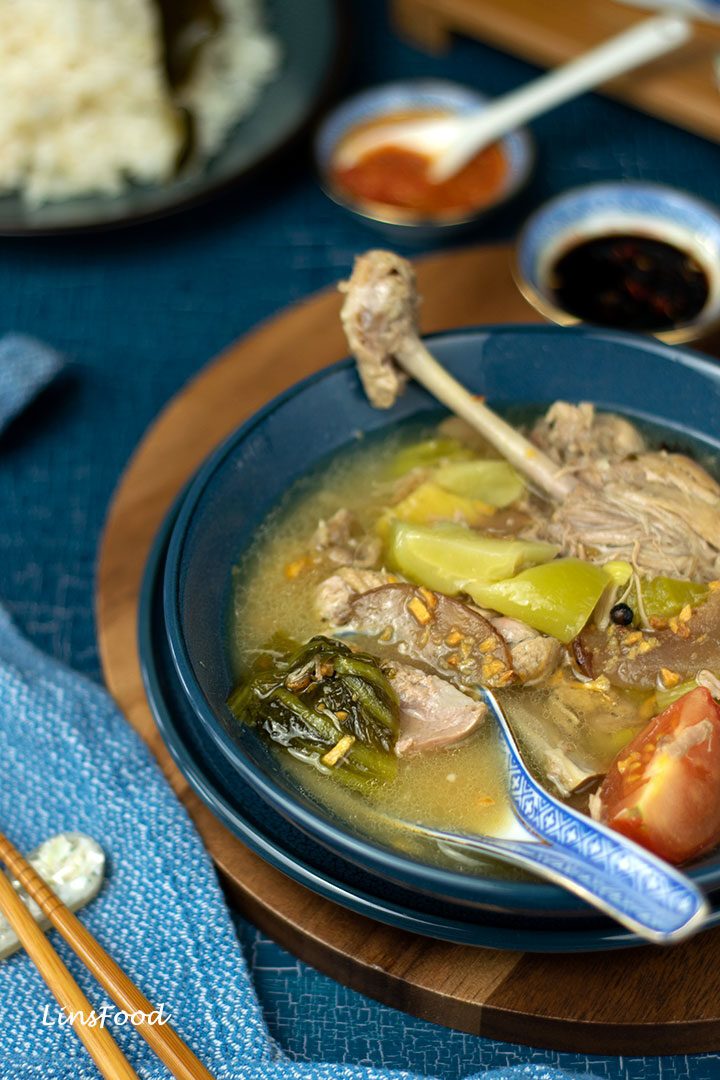
Brandy in Itek Tim
Brandy and duck are a match made in heaven. I use the 2 very regularly, as in this Rillettes de Canard (Potted Duck) recipe on LinsFood. Apparently, having a shot (or 2) of brandy just before bedtime was a favourite pastime of the old Nyonya ladies.
My mum used to tell me that when she had us, the nurses would encourage her to either drink a little Guinness or a shot of brandy at night for restorative purposes. Which she did!
So using brandy in itek tim might be a hand me down from any of the 3 European colonisers of Malacca (Portugal, Holland, UK), or perhaps just the Brits. However it came about, adding brandy lends a subtle fruity and sweet flavour that is the perfect foil to the tartness in Itek Tim.
Don’t do alcohol? Don’t sweat it. Just omit it, no need to sub it with anything else.
How to Serve Itek Tim?
It is best enjoyed with some steamed white rice (or brown, if that’s your thing). Make it a part of an East or South East Asian meal and create your own tok panjang!
I always, always serve it with these 2 condiments, see images on this page.
- chilli chuka – a simple, homemade, tangy chilli sauce. Click here for the recipe.
- chopped up bird’s eye chillies in dark soy sauce – this gives a beautiful balance to our soup, as well as heat.
Make Ahead Itek Tim
Itek Tim definitely tastes better the next day. So you can make it a day before. Cool to room temperature and store in the fridge for up to 2 days. The next day, just heat it gently to a simmering point.
The added advantage here is that you can skim off the hardened fat before reheating. Reserve the fat for stir-fries and such.
If you are making this Peranakan soup with the intention of heating it up later, don’t overcook your duck meat initially. Stop before it starts to fall away from the bones. Otherwise, you’ll end up with a messy soup with meat that’s fallen apart from overcooking.
If it’s leftovers that you’re reheating, then it really doesn’t matter, right?
And now, shall we get cooking? Would you believe it took me about 8 hours just to write up this article and recipe?! Not even counting the cooking, photoshoot and editing! That’s 2 whole days of work.
And ya thought food blogging was easy, huh?
If you enjoy the recipe, drop me a comment and let me know. Feeling like a star? Don’t forget that 5-star rating!😉
If you make this recipe, post it on Instagram and tag me @azlinbloor and hashtag it #linsfood.
Lin xx
More Nyonya Recipes
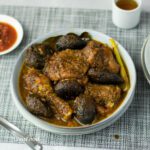
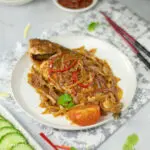
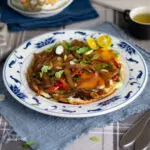
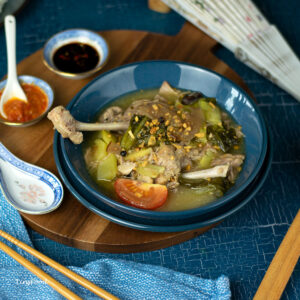
Itek Tim (A Nyonya Duck Soup)
Ingredients
- 300 g pickled sour mustard leaves
- 4 duck legs about 1 kg / 2.2 lb
- 750 ml water
- 500 ml chicken stock or 500 ml (2 cups) water + stock cube/pot
- 3 preserved plums
- 5 asam gelugur pieces
- 2 medium tomatoes
- ½ tsp salt
- 2 Tbsp brandy
Aromatics and Spices
- 2 medium cloves garlic
- 2.5 cm ginger
- 2 bird's eye chillies
- ½ tsp black peppercorns
- 1 star anise
For Serving (Optional)
- 4 bird's eye chillies
- 4 Tbsp dark soy sauce
- chilli chuka as needed
Instructions
Pickled Mustard Leaves
- Soak the mustard leaves in tap water, in a bowl, for 5 minutes only. We want to retain the sour flavour. Put a timer on!

- At the end of 5 minutes, drain and chop up into rough bite sized pieces.

Aromatics and Vegetables
- Peel the garlic but leave them whole.Slice the ginger.Leave 2 chillies whole, roughly slice the others and place in a small condiment bowl. Pour the dark soy sauce over and set aside until serving. This allows the chillies to infuse the soy sauce.Quarter the tomatoes.

The Duck Legs
- Using a cleaver or large, sharp knife, chop the duck legs into 3 pieces each. Rinse well to get rid of grit from the bones.

Let's get Cooking
- Take a large saucepan and drop the duck pieces in and cover with the water and stock. Bring to a boil on medium-high heat.Turn the heat to medium and cook for 5 minutes, skimming any scum and grit that floats to the surface.

- Add the preserved plums, asam gelugur, salt, garlic, ginger, 2 whole bird's eye chillies, peppercorns, star anise and 1 Tbsp pf the brandy and bring back to a simmer.Reduce the heat to low, cover and cook for 30 minutes, or until the duck is cooked. You may need 40, if your duck pieces are large. But we've still got 10 minutes of cooking time.

- At the end of 30 minutes, add the mustard leaves and cook, on a simmer for 10 minutes. If you have too much liquid, leave it uncovered. If not, cover and cook.

- At the end of 10 minutes, taste your soup and add more salt if necessary. Take it off the heat and stir in the tomatoes and the other 1 Tbsp of the brandy.Cover and let it rest for 5 minutes before serving.


8 thoughts on “Itek Tim (A Nyonya Duck Soup)”